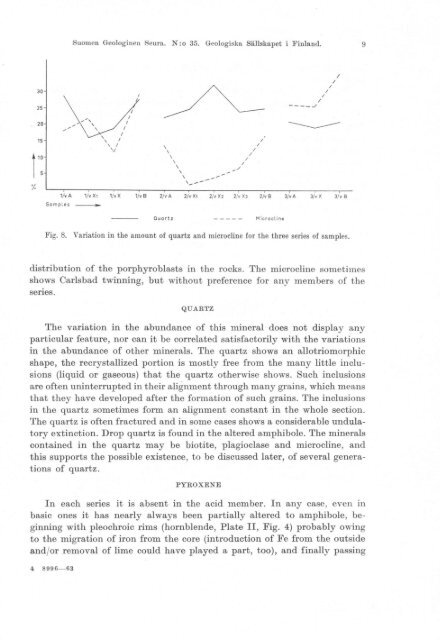COMMISSION GEOLOGIOUE - Arkisto.gsf.fi
COMMISSION GEOLOGIOUE - Arkisto.gsf.fi
COMMISSION GEOLOGIOUE - Arkisto.gsf.fi
Create successful ePaper yourself
Turn your PDF publications into a flip-book with our unique Google optimized e-Paper software.
Suomen Geologinen . eura. N: 0 35. Geologiska Sällskapet i Finland.<br />
9<br />
30<br />
25<br />
20<br />
15<br />
r:<br />
I<br />
I<br />
, I<br />
'J<br />
1/v A 1/ v X, 1/v X<br />
Somples ~<br />
I<br />
I<br />
I<br />
I<br />
I<br />
l<br />
\<br />
\<br />
\<br />
\<br />
\<br />
\<br />
\<br />
'--<br />
/<br />
/<br />
/<br />
/<br />
/<br />
/<br />
_/<br />
/<br />
/<br />
/<br />
/<br />
/<br />
/<br />
----j<br />
1/v B 2/v A 2/v X, 2/v X2 2/v Xl 2/v 8 3/v A 3/ vX 3/ v8<br />
Ouortz<br />
Microclin&<br />
Fig. 8. Variation in the amount of quartz and microcline for the three series of sampIes.<br />
distribution of the porphyroblasts in the rocks. The microcline sometimes<br />
shows Carlsbad twinning, but without preference for any members of the<br />
series.<br />
QUARTZ<br />
The variation in the abundance of this mineral does not display any<br />
particular feature, nor can it be correlated satisfactorily with the variations<br />
in the abundance of other minerals. The quartz shows an allotriomorphic<br />
shape, the recrystallized portion is mostly free from the many little inclusions<br />
(liquid or gaseous) that the quartz otherwise shows. Such inclusions<br />
are often uninterrupted in their alignment through many grains, which means<br />
that they have developed after the formation of such grains. The inclusions<br />
in the quartz sometimes form an alignment constant in the whole section.<br />
The quartz is often fractured and in some cases shows a considerable undulatory<br />
extinction. Drop quartz is found in the altered amphibole. The minerals<br />
contained in the quartz may be biotite, plagioclase and microcline, and<br />
this supports the possible existence, to be discussed later, of several generations<br />
of quartz.<br />
PYROXENE<br />
In each series it is absent in the acid member. In any case, even in<br />
basic ones it has nearly always been partially altered to amphibole, beginning<br />
with pleochroic rims (hornblende, Plate II, Fig. 4) probably owing<br />
to the migration of iron from the co re (introduction of Fe from the outside<br />
and/or removal of lime could have played apart, too), and <strong>fi</strong>nally passing<br />
4 8996- 63
















